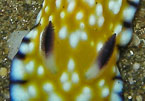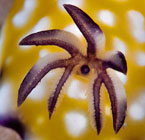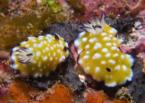_______________
Additional Photos

flat posture

side

underside

rhinophores

branchia

young

large, 65 mm

feeding

mating

egg mass
_______________
GALLERY

|
Goniobranchus vibratus (Pease, 1860)

Maximum size: 65 mm.
Identification:
This
species has a bright yellow notum, with white pustules, that's
edged in bluish-purple scallops. The rhinophore tips are
dark purple and the gills are white with dark purple edges and tips. It
can be
distinguished from other yellow-and-white chromodorids by the
combination of white pustules with purple-tipped rhinophores and
gills.
Natural history:
Goniobranchus vibratus
is a commonly seen, diurnal species found in rocky habitats in
moderately protected to exposed locations at depths of < 1 to 24 m
(< 3 to 80 ft).
Rarely, it may occur in tide pools or the low intertidal (Bertsch and Johnson, 1981) and in Halimeda kanaloana beds.
It has been observed feeding on a dark purple encrusting sponge,
probably Chelonaplysilla
violacea. When crawling, it rhythmically raises and lowers the anterior
edge of its mantle and it also vibrates its gills. It lays a peach egg
mass of 2-3 whorls. The eggs are associated with small masses of dark
orange extra-capsular yolk that remain in the mass after hatching.
Hatching occurs in about 7 days in the laboratory.
Distribution:
Big Island, Maui, Lanai, Molokai, Oahu, Kauai, Niihau, Midway and Kure (also Johnston Atoll): also known from the Marshall
Islands and Japan.
Taxonomic notes:
This
species was listed as Hypselodoris
vibrata (Pease, 1860) in Kay, 1979 and Kay & Young, 1969. While many chromodorids
vibrate their
gills, it was named for
the habit. It's listed as Chromodoris vibrata (corrected in 2019 printing) and is referred to as the "trembling nudibranch" in Hoover,
1998 & 2006. It's also listed as C. vibrata in Bertsch and Johnson, 1981. It was first reported from Hawaii in Pease, 1860 (as Doris vibrata). Kay, 1979 considers Doris propinquata Pease, 1860 to be a synonym.
Photo: PF:
probably feeding:
Observations and comments:
Note
1: ( )
|
|











